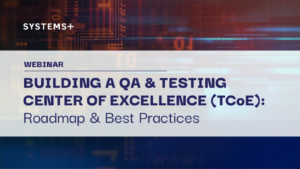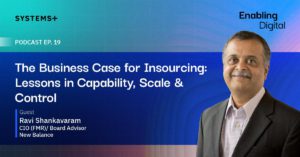Leverage the cloud and create a next-generation IT capability of growth

The cloud is a means, not an end to the transformation. While large organizations successfully implement or adopt a cloud-first strategy for new systems, many struggle to extract the full value of moving the bulk of their enterprise systems to the cloud. This is because they tend to move IT systems to the cloud instead of chalking the transformational strategy needed to realize the full potential of the cloud. Just moving legacy applications to the cloud using a lift-and-shift procedure will make IT architectures complex, cumbersome and costlier instead of yielding the benefits that cloud infrastructure and systems are meant to provide.

The cloud acts as a force multiplier. Its actual value is best realized when you make it a part of a larger strategy to pursue digital transformation. Such a strategy is enabled by the standardization and automation of the IT environment, adopting a modern security posture, working with an automated agile operating model and leveraging new capabilities to drive innovative business solutions. Organizations that view cloud capabilities in this way can create a next-generation IT capable of enabling business growth and innovation.

In an increasingly digitalized environment, whether a business requires utilizing cloud services is no longer the question. The considerations are more around which type of cloud services are required and how to execute a successful cloud migration. With the movement towards a multi or hybrid cloud environment using public cloud platforms, the typical challenges that you might face include:
Based on the current scenarios, let’s understand what steps are essential to consider when it comes to cloud adoption for your organization.

Understanding what would constitute a perfect cloud environment for your business is critical to cloud adoption. Discovering the cloud value and cloud migration paths is essential to create a sustainable cloud-based transformation. The parameters to achieve a successful migration need to be defined:

Custom application development, monitoring and scaling in line with your unique PaaS, IaaS or SaaS needs is the way to go when it comes to cloud adoption. Determining optimal data strategies for your organization and content distribution processes is mandatory too. You should have feasible and cost-efficient solutions for your mobile, IoT, Ecommerce or machine learning depending on your priorities.

Creating effective enterprise cloud architecture requires collaboration with the business and operations teams for you to understand feasibility, usage and scale. You must first define business goals and together with a cloud reference model, figure out what traditional components from the current application architecture can be migrated to the cloud. As part of most cloud architectures, you’ll need to keep a robust security posture and leverage containerized solutions for adding value to your cloud adoption.

Using DevOps with cloud services allows you to follow a CI-CD model for pipeline automation when it comes to application, database or cloud services in general. A strong cloud presence with a DevOps culture means that your entire delivery pipeline is more responsive to change. DevOps integration targets feature development, automation testing, quality testing, product delivery and maintenance releases in order to improve reliability and security and provide faster development and deployment cycles. You can expect the following business outcomes with this combination:
The cloud-DevOps combination makes your delivery pipeline agile, flexible and secure enough to adapt to changing trends and consumer preferences.

You needed just one cloud vendor in the old cloud days. Today you need an all-encompassing multi-cloud strategy across multiple public clouds or a hybrid cloud strategy across your on-premise data centers and the public cloud.
Managing IT resources, ranging from servers and storage to complex applications, requires considerable time, effort and expertise. Successful companies are focusing on their core business and not managing data centers or their applications. With a fully managed cloud service, businesses can use the power of cloud computing, ranging from basic compute and storage to complex technologies such as AI and ML.

Build and run applications without thinking about provisioning, maintaining, and administering the servers. Serverless helps reduces the complexity for building a modern scalable application, while enabling a high level of independent services with no servers to manage and a pay-per-use pricing model. You no longer need to worry about ensuring application fault tolerance and availability. This allows you to focus on product innovation while enjoying faster time-to-market.
At Systems Plus, we believe that with cloud computing, organizations get to have it all: scalability, agility, flexibility and efficiency besides saving on costs and time. Adopting the cloud is far more complex than simply using someone else’s datacenter. Cloud adoption requires organizations to fundamentally shift their model and behaviors to a consumption model rather than a Capex model.
We have the proven skills, expertise and certification to help your organization successfully and strategically adopt the cloud. With experience in all layers of the platform: infrastructure, application, data, security, policy and pipeline, we navigate the people, processes and tools that script success for you. As your strategic partner and a one-stop provider, we help your organization get cloud-fit by guiding you to discover the right cloud adoption strategy and ensure full-service cloud adoption. Giving you our best to help you make the most. And stay ahead of the competition!






